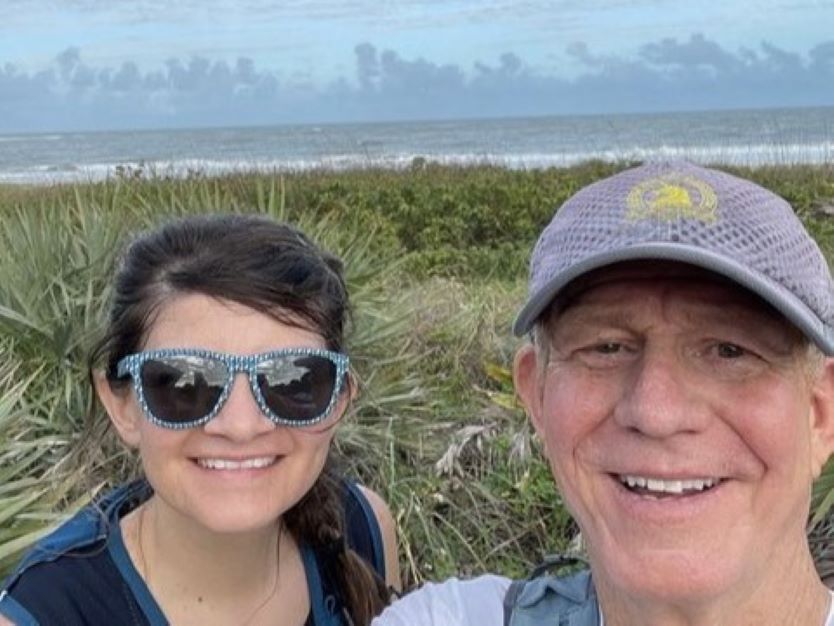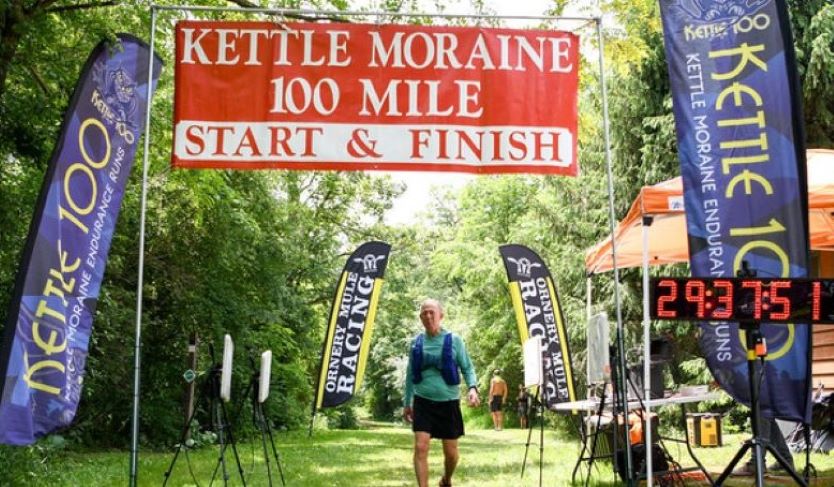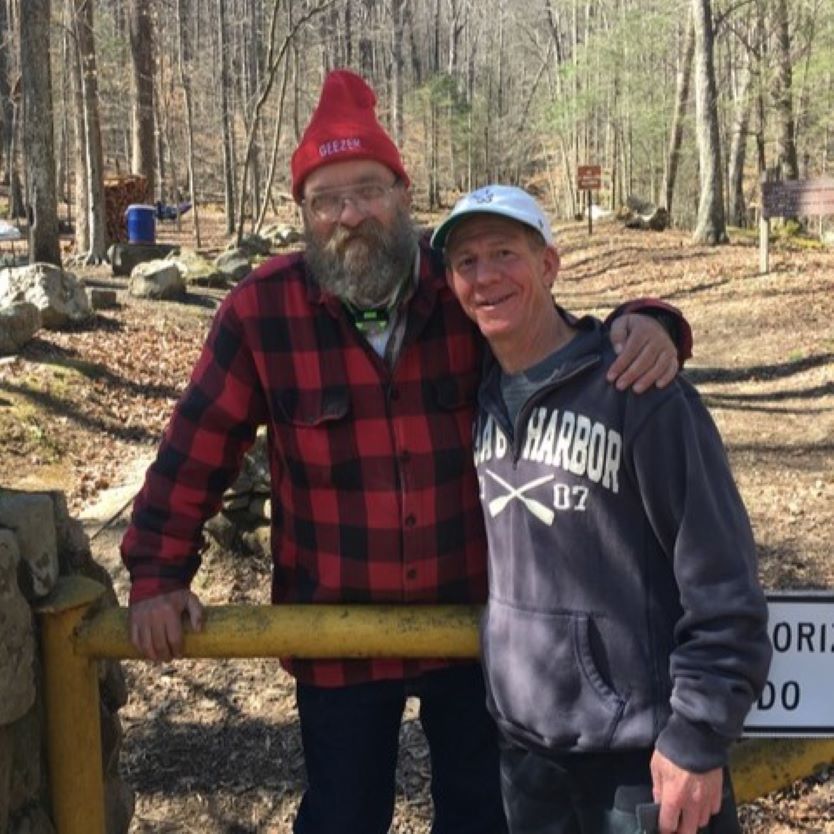Ultrarunner Jon Hendren became a runner at age 52, when his older brother, Jeff Hendren, called him out for being unhealthy, while they visited their mom to help her bury their stepfather.
“I was grossly out of shape. Jeff, who is a triathlete, said, ‘You need to take care of yourself, or you’ll find an early demise like our dad and grandfather. I was 45 pounds overweight with a sedentary lifestyle and high cholesterol,” said Hendren. Their dad had just passed away from heart disease, the same condition that had caused their paternal grandfather’s organ failure. It was February 2014.
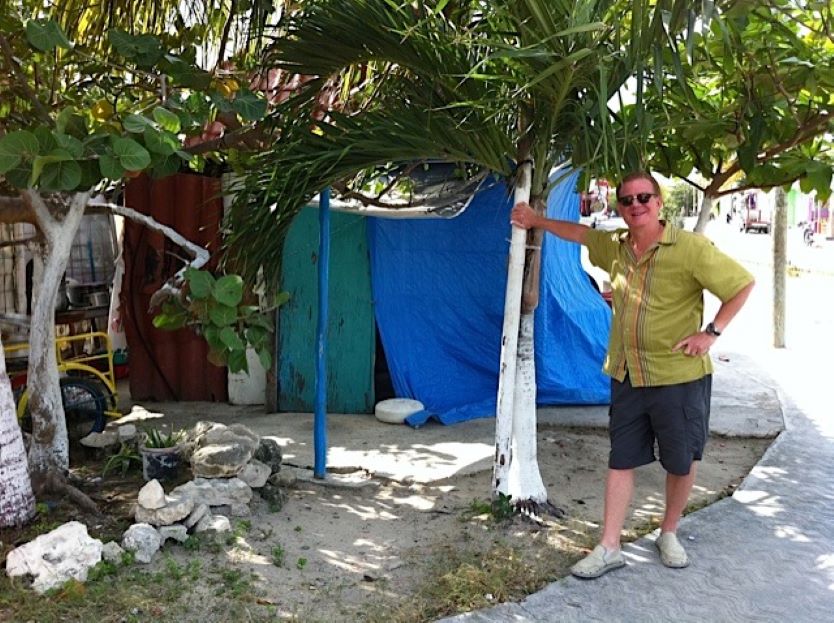
Jon Hendren in Isla Mujeres, Mexico, in 2013, before making the decision to adapt a healthier lifestyle. All photos courtesy of Jon Hendren.
Hendren took the wake-up call. He joined a YMCA (Young Men’s Christian Association) gym in his home city of Indianapolis, Indiana, started running, and in a five-month period, shed 45 pounds. Through the gym, he joined a training group for a local race called the OneAmerica Mini-Marathon, which he always thought was a five-kilometer run.
Three weeks before the race, the group coach announced they were leaving on a 10-mile run. “I asked, ‘Why are we running so far?’ She said, you’ll be running 13.1 miles, so this is our next training run. I said, ‘What in the world! This thing is called a mini.’ I hadn’t run in my entire life,” said Hendren, who finished the race in under two hours and has been in love with running, the runner’s high, and races ever since.
Within three weeks of the OneAmerica Mini-Marathon, he ran a second half marathon. Within six months, he finished the Chicago Marathon and Monumental Marathon in Indianapolis. Less than a year after he started running, he registered for a 50k — the Chicago Lakefront 50k, along the Lake Michigan shoreline.

Jon Hendren in the San Juan Mountains in Colorado in 2021. Trail running continues to be a huge part of his life.
“Within a year, I transitioned from eating bad foods and being sedentary to running a 50 miler. I went from nothing to runner to ultrarunner in 12 months. After running 50 miles on trail, I said, Do I have to run streets and roads?” Hendren reflected, who’d also switched his diet to be more plant-based. He pursued trail races and ultramarathons, while also ticking off iconic road races including the New York Marathon and Boston Marathon.
“What I enjoy most about running ultras is being out and one with nature — it’s just you and the trail. How fast or slow someone else runs doesn’t affect me. I run my own race and at my own pace — testing my endurance, skillsets, and seeing what my body can do now,” said Hendren.
Hendren ran the Ice Age Trail 50 Mile in southern Wisconsin, one of the oldest 50 milers in the U.S. Midwest, for the first time in 2015, and he’s run the event every year since — except in 2020.
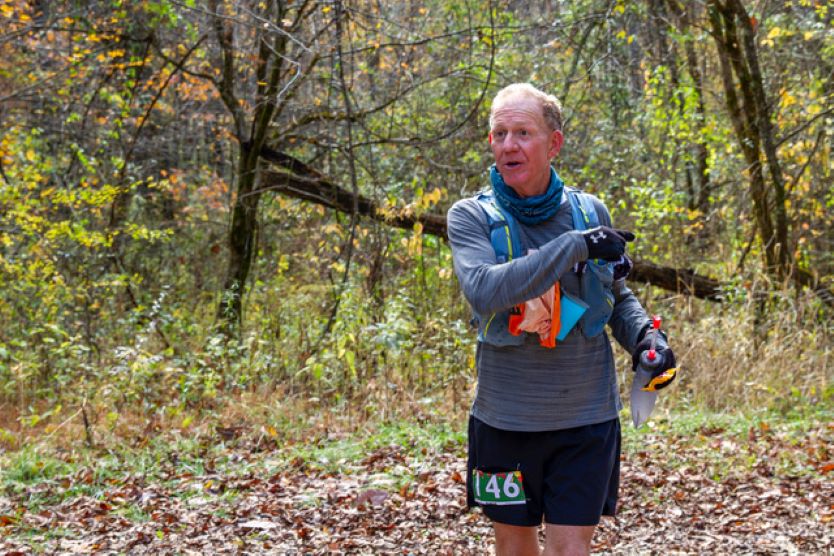
Jon Hendren racing the Tecumseh Trail Challenge 50k in November 2020, in Yellowwood State Forest, Indiana.
By the time the world was grappling with the onset of the COVID-19 pandemic, Hendren was battling cancer. During a routine physical in May 2018, Hendren’s doctor noticed his bloodwork was not normal and requested that Hendren visit a hematologist for an additional checkup. Hendren was focused on training for Leadville 100 Mile, but felt weak, which he put down to anemia. At his next year’s physical, his doctor said, “I don’t see that you got your bloodwork done. You need to go to an oncologist — today.” By that point, Hendren’s bloodwork was ugly. It was November 2019.
Hendren was diagnosed with myelodysplastic syndrome (MDS), a bone marrow disorder that can evolve into acute myeloid leukemia. He dove into reading white papers on the disease and noticed a small grouping of physicians had authored the majority of the published research. The phone numbers of the two most frequently listed researchers were listed on the published articles, so Hendren texted them both.
“I texted them on their cell phones and said, ‘Here’s my complete blood count, my diagnosis coming from doctors in Indiana, and I want to come see you, because you’re probably one of the best doctors for this on the planet. They both happened to be chairmen of their leukemia departments, meaning they don’t typically take patients, because they’re teaching others,” said Hendren.
Dr. Richard E. Champlin, at the University of Texas MD Anderson Cancer Center in Houston, Texas, agreed to treat Hendren. Dr. Champlin is the chair of the Department of Stem Cell Transplantation and Cellular Therapy in the Division of Cancer Medicine.
By January 2020, Hendren essentially moved to MD Anderson for an immersive, isolated six-month treatment plan. “They said, ‘You have a 50/50 chance of survival if we can find a stem cell donor that matches you. If we can’t find a donor, you have one year,” said Hendren, who still tried to run at that time but couldn’t due to his health.
First, Hendren went through a clinical trial that involved two rounds of chemotherapy. The chemo infusions were necessary for a chance of survival, but also entailed risk, being an aggressive form of chemo, which would compromise his immune system greatly.
Hendren rotated in and out of the hospital and an annexed hotel for this time, where he was allowed to walk the hallways for exercise. All of the doctors in the vicinity, and Hendren, had to wear a full head-to-toe protective HAZMAT suit, mask, and booties to prevent any contamination.
The second step was for Hendren to receive a stem cell transplant by replacing his blood with a match. Fortunately, his younger brother, Scott Hendren, was able to donate. The blood transplant likewise carried the risk of graft-versus-host disease, when the patient’s cells view the donor’s cells as foreign, which can be potentially life-threatening.
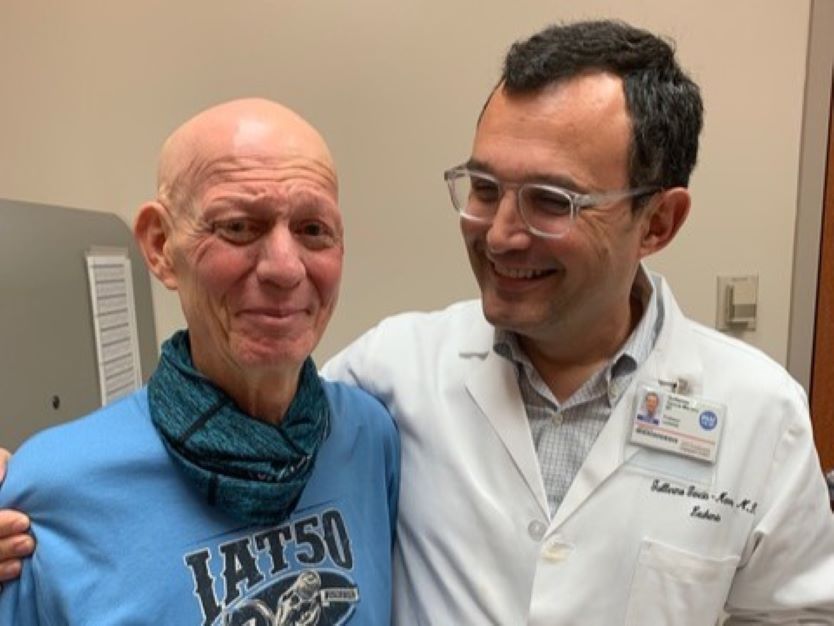
Jon in the hospital in February 2020 with Dr. Guillermo Garcia-Manero, having just been told that the chemotherapy was successful and that he was ready to proceed to the stem cell treatment. Jon says that Dr. Garcia-Manero was instrumental in saving his life, having designed and prescribed the form of chemo required to treat Jon’s cancer.
Despite the risks of the chemotherapy and blood transplant, Hendren knew he would not survive without the treatments, so he had no choice but to take a leap of faith.
Fortunately, Hendren was up and walking the floor of the hotel within 24 hours of the blood transplant. The following week, he slowly strolled three miles in a single day, back-and-forth along the hallways on the 19th floor. Each lap was one-eighth of a mile.
“I had to do dozens and dozens of laps while I was hooked up to nine bags of liquid. I had a metal stand called a tree with drip bags with saline solution, sugar, or medicine. I walked in this HAZMAT suit with the stand full of liquids pumping into me,” said Hendren.
Over the coming weeks, Hendren maintained positivity and optimism for his recovery. His life partner, Nicole Pence, continued to be a huge support on his journey. He shared his first Facebook post on April 5, 2020:
I am improving daily and will know if the stem cell therapy worked after my next bone marrow biopsy, April 10th. Currently we have determined the chemo killed off everything and the new blood cells have no mutations or deletions. But we need Scott’s stem cells to ‘engraft’ and give me a whole new immune system. While they can see numbers improving in my blood work daily, they need a bone marrow biopsy to determine if the engrafting is successful. Fingers crossed, we are still living in a 50/50 chance for a cure. I like to think of that as a ‘glass is half full’ scenario instead of the other. We have been fortunate enough to have researched and found the world’s best doctors for myelodysplastic syndrome and each step of the process has been successful so far. No reason to stop now … these last few steps should be as well.
Within a month, Hendren was running outside again and shared another heartfelt update on May 18, 2020:
My Garmin says I’m ‘overreaching’ with my training. Needless to say, I’m running now, not nearly as far nor at the pace I used to keep. But having the sun warm my face, the sweat roll down my neck, and my legs ache from pushing it to the edge, I couldn’t be happier and look forward to seeing everyone in June, sometime. A big thanks to all of you who have stayed current with my progress, and keep me motivated to do better. Your comments and posts have made me laugh on the days when it seemed like nothing but dark clouds hung overhead. Nicole has been unbelievable through all of this. Constantly making sure I’m being careful and safe, even from afar. Saw my transplant doctor and his team, today. Dr. Champlin was almost giddy with delight over my blood work. They said, ‘… This couldn’t be any better, perfect numbers … you’re ready to go home… just one more bone marrow biopsy in a few weeks to confirm we are still headed in the right direction, and you can go.’ … And I thought it was a good day because my new running shoes came in the mail! So, I’ll take this little victory and add it to all of the other little victories I’ve had this spring … and count myself as one of the lucky ones.
By June 2020, Hendren was allowed to leave the hospital and return home. “With my brother Scott’s new blood, I got a new life. If you asked me what I wanted prior to 2020, I wanted to run a big 200-mile race out West. Now, I’m happy to be alive. I’m happy to get out every day and run,” he said.
The return-home rules were strict because his immunity was completely wiped away and no vaccine existed yet for COVID-19. No plants were allowed in his house. No birds, no dogs, no pet fish. Someone had to sterilize the home before his arrival. Hendren was completely isolated at home until February 2021.
Pence wiped down and cleared his house and filled the fridge with groceries. They would meet for long runs and stay several feet away from each other.
“The situation was, ‘We’ve worked really hard to give you a new life — don’t mess it up,’” said Hendren, who was also $1.5 million in debt.
By November 7, 2020, Hendren ran his first 50k since his diagnosis. On the one-year anniversary of his stem cell transplant from his brother Scott, he was still in remission and cancer-free, Dr. Dugan told him over the phone on March 11, 2021.
“They don’t call it cured for five years, and I’m in full remission now. I hope to stay that way,” said Hendren.
He continued, “I want to be a 100-mile runner and do more 100-mile races. That’s my favorite race distance. I also enjoy 50 milers, because they seem so easy! And now that I’ve battled cancer and finished a 100-mile distance, I am eager to see what my body is still capable of doing.”
Hendren DNFed his first century-distance attempt, the 2018 Leadville 100 Mile. Becoming “hellbent” on finishing a 100 miler, he attempted — though didn’t reach the finish line of — six more 100-mile races. He finished his eighth pursuit, the Kettle Moraine 100 Mile in Wisconsin on June 11, 2022, after his battle with cancer.
Cancer has helped shape Hendren in new ways. “I’m just happy to be alive. I feel like I have a lot more patience now,” he said, and he also no longer works full-time. Instead, he does project work, now, as a builder.
Hendren’s passion for the sport and community is clear, said friend and running partner Matt Roberts, who first met Hendren when Roberts was preparing for the Potawatomi Trail Runs 100 Mile in April of 2021. The race was Roberts’s first 100 miler and he needed a pacer. Hendren volunteered to help at the race and offered advice over several phone calls leading up to the event, where he paced Roberts through 40 miles of muddy, gnarly terrain.
“On any given weekend, one will find Jon running a local trail, meeting the community, and building friendships … Jon would be the first to step in and help a struggling crew, hand off a ginger ale to a sick runner, or give you a much-needed calf massage mid-race. Jon is incredibly invested and celebrates the successes of the people around him even more than his own successes. Most recently we were out in Leadville, Colorado, for the Leadville 100 Mile, and I watched as tears ran down his face as our fellow runner, Dan Morrow, ran across the finish line. You can’t overstate how much Jon gives to this community,” shared Roberts.
Hendren said, “I feel so extremely fortunate that I was able to find and get help from the correct doctors and that I’m able to be here to go out for a run and enjoy life. I’m enjoying a new phase of life. From my early 20s to now, I worked my butt off building and running cafes and coffee shops. Now, I will take on little projects here and there — and run. I want to enjoy life to its fullest every day.”
Call for Comments
- Did you find Jon’s story inspiring?
- Have you or someone you know overcome a health crisis and returned to running too? Tell us your stories!

